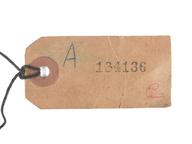

Circular metal pendant
- Made:
- 1850-1920 in unknown place








Circular metal pendant, pierced for suspension, engraved Latin and cabalistic inscriptions and signs
Sigils are symbols believed to convey magical powers. Their practical use for beneficial effect was outlined by German polymath and physician Heinrich Cornelius Agrippa in his sixteenth-century work ‘Three Books of Occult Philosophy’.
This talisman, a circular metal disc perforated with a hole near the edge so it could be worn close to the body, bears the planetary sigil for Jupiter and Latin inscription "Confirmo Deus Potentissimus" translating as "Strengthen me, O God most powerful". The reverse side is inscribed with a magic square representing Jupiter, surrounded by Hebrew words and the number 136, which corresponds to the total value of the numbers associated with each Hebrew letter in the square.
Details
- Category:
- Ethnography and Folk Medicine
- Collection:
- Sir Henry Wellcome's Museum Collection
- Object Number:
- A657575
- Materials:
- steel, ? material
- type:
- pendants
- credit:
- Loan, Wellcome Trust




